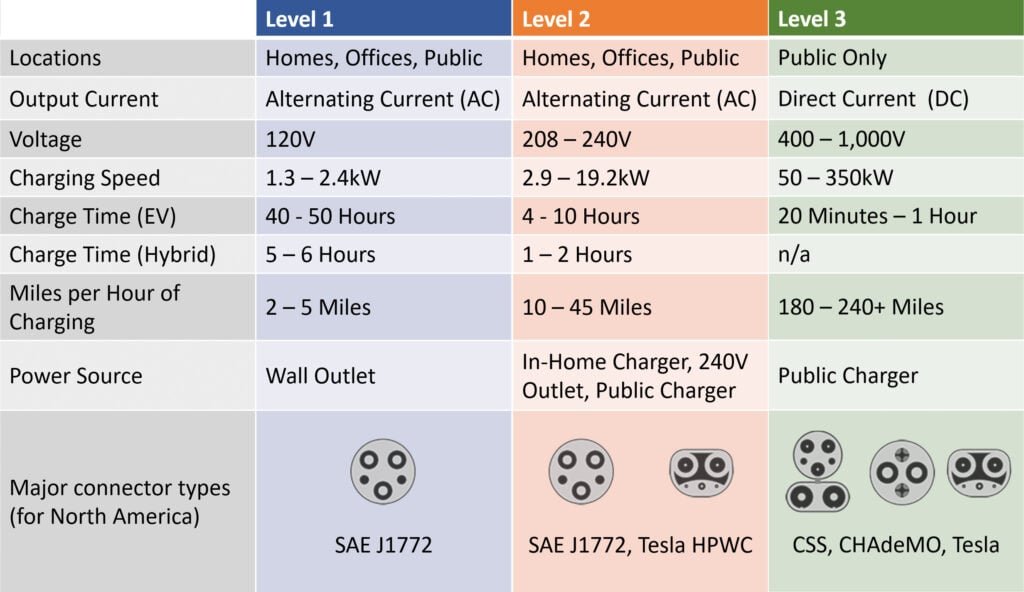
Voltage and Power: Level 1 chargers operate on a standard 120-volt household outlet, A Level 1 will deliver around 1.2 kW to the vehicle
Charging Speed: This level adds approximately 2 to 5 miles of driving range per hour of charging.
Usage: Ideal for overnight charging at home, especially for plug-in hybrid electric vehicles (PHEVs) or for EV owners with low daily mileage.
Key Advantages:
✅ No need for professional installation (compatible with standard household outlets)
✅ Equipment cost close to zero (standard in car purchase)
✅ Low power characteristics to protect the long-term health of the battery
Voltage and Power: Level 2 chargers utilize a 240-volt outlet, Level 2 charger ranges from 6.2 to 19.2 kW, with most chargers around 7.6 kW.
Charging Speed: They can add 32 miles of driving range per hour of charging.
Usage: Commonly found in homes, workplaces, and public charging stations, Level 2 chargers are suitable for daily charging needs and are often installed in residential garages or parking areas.
Technological Breakthroughs:
🔌 Intelligent charging management (supports time-of-use tariff optimization)
🔌 OCPP protocol compatibility (for commercial operation scenarios)
🔌 Dynamic load balancing (simultaneous charging of multiple devices)
Voltage and Power: DC Fast Chargers operate at 480 volts, delivering between 60 kW and 400 kW of power.
Charging Speed: They can add 173 to 298 miles of driving range in just one hour of charging.
Usage: Primarily located in public charging stations along highways and in urban areas, DC Fast Chargers are designed for quick top-ups during long trips.
Selecting the appropriate charging level depends on several factors:
| Charger Type | Equipment Cost(USD) | Installation(USD) | Total Range(USD) |
|---|---|---|---|
| Level 1 | N/A | 0-500 | 0-500 |
| Level 2 | 400-1,200 | 800-2,000 | 1,200-3,200 |
| DC Fast | 30k-150k | 20k-100k | 50k-250k |
Europe
| Charger Type | Equipment (EUR) | Installation (EUR) | Total Range (EUR) |
|---|---|---|---|
| Level 1 | N/A | N/A | N/A |
| Level 2 | 600-1,500 | 1,000-3,000 | 1,600-4,500 |
| DC Fast | 40k-180k | 30k-120k | 70k-300k |
| Region | Level 1 | Level 2 | DC Fast |
|---|---|---|---|
| NA | <$50 | $100-300 | $3k-8k |
| EU | N/A | €80-250 | €2.5k-7k |
Key Components:
Level 1/2: Socket replacement, circuit inspection
DC Fast: Cooling system maintenance, connector replacement (8-12% annual rate), software updates
Regional Variations
Grid Standards: EU residential 230V single-phase vs. NA 120V system
Certifications: UL in NA vs. CE+EN 61851 in EU
Grid Upgrade: NA requires 100-480kW connections, 80% new EU installations include energy storage systems
1. Charging power selection
Level 1 (Portable):
North America 120V/15A (1.4-1.9kW), Europe 230V/10A (2.3kW)
Daily range supplement: about 50-80km (suitable for short-distance commuting)
Cost: 600 for the device, no professional installation required
Level 2 (wall-mounted):
North America 240V/40A (7.7-11.5kW), Europe 400V 3-phase (11-22kW)
3-6 times faster charging, 4-8 hours to full capacity
Installation cost: North America 2,000, Europe €1,000-€3,500 (including circuit modification)
2. Intelligent Function Configuration
Basic version: LED status indication + overvoltage protection
Advanced version (recommended)
WiFi/4G remote control (OTA upgrade support)
Time-sharing tariff charging scheduling (save 30% electricity cost)
Vehicle identification authentication (RFID/APP unlocking)
3. Vehicle model compatibility verification
American Standard Vehicles: Confirm SAE J1772 interface compatibility
European standard vehicles: check IEC 62196 Type2 interface version
Tesla: Factory adapter (250) required
IP65 / IK10
Three Casing Design
Power configurable Up to 80A(19.2kW)
5” (7”optional) LCD Screen
Plug and Charge ISO 15118 (hardware-ready)
We will send detailed technical info and quotation to you!